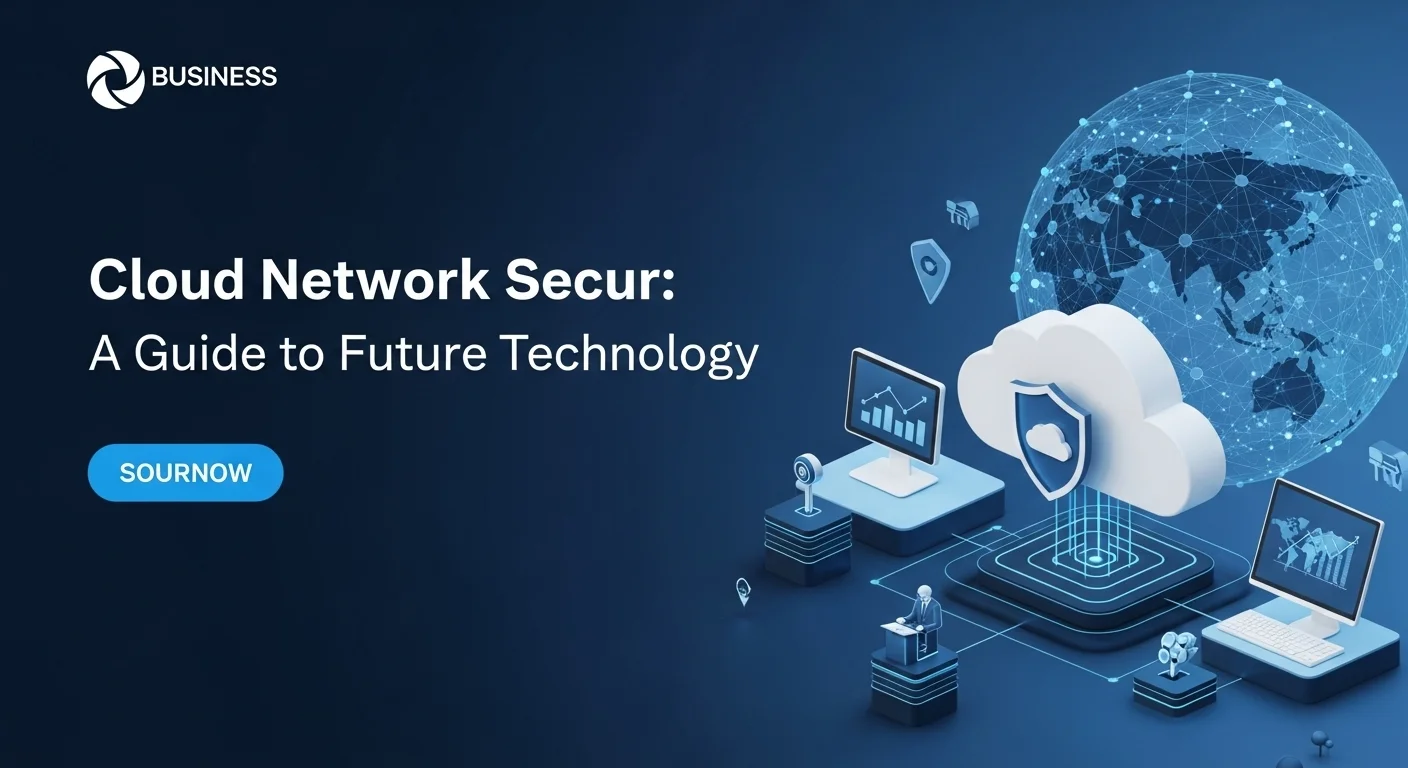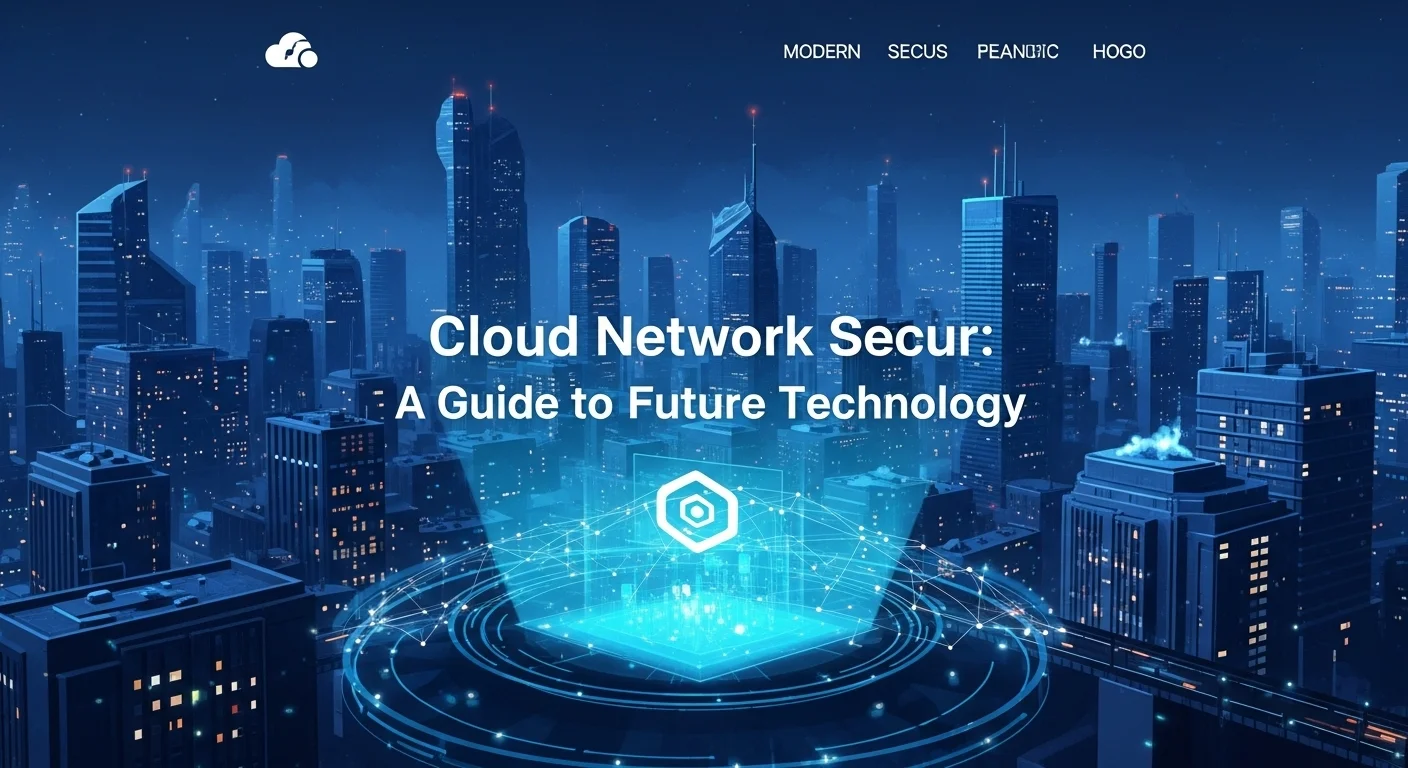Your Practical Guide to Cloud Network Security: Protecting Your Business

Executive Summary
Moving to the cloud is one of the smartest decisions a business can make today for growth and flexibility. But from my years in the trenches of cybersecurity, I've seen this transition introduce some serious security headaches if not handled correctly. This article is my personal guide to navigating cloud network security. We're going to break down what it really means to protect your data, apps, and infrastructure in the cloud. We'll look at how this new world of security is different from the old 'castle-and-moat' approach and what that means for you. Whether you're a business leader or a tech enthusiast, my goal is to give you a clear understanding of everything from core concepts and modern models like Zero Trust and SASE, to the hands-on tools offered by giants like AWS, Azure, and Google Cloud. Think of this as your roadmap to building a secure cloud setup that you can trust, one that supports your business, keeps you compliant, and lets you sleep at night.
Table of Contents
Table of Contents
What is Cloud Network Security and Why Does It Matter?
In my experience, the moment a company moves to the cloud, their entire concept of a 'secure perimeter' changes. That old idea of a safe internal network protected by a strong outer wall simply vanishes. This is where cloud network security becomes absolutely critical. It’s not just a buzzword; it's a specialized discipline focused on one thing: protecting your digital assets in a cloud environment. This means we're talking about all the policies, tools, and practices needed to guard your data, applications, and infrastructure against cyber threats, whether you're using a public, private, or hybrid cloud setup. The main goal is to keep your information confidential, ensure its integrity, and make sure it's always available when you need it. Unlike traditional on-premise security, which was all about defending a physical location, security in the cloud has to protect a fluid, virtual environment that's spread all over the globe.
I can't stress enough how important a solid cloud security strategy is. When you move your critical data outside your own walls, your potential for attack grows exponentially. The biggest threats I see aren't always sophisticated hacks; often, it's simple human error, like a misconfigured setting, an insecure API, or stolen credentials. A single mistake can lead to devastating consequences—not just financial loss, but damage to your reputation and steep regulatory fines. That's why building a secure network in the cloud is a core business function, not just an IT task. It's what allows you to innovate safely, protect your intellectual property, and maintain your customers' trust. Remember the shared responsibility model: the cloud provider secures the cloud itself (their hardware and facilities), but you are responsible for securing what you put *in* the cloud. A good cloud network security plan is what empowers you to handle your part of the deal effectively.
The Evolution: From Traditional Security to the Cloud
To really get why cloud security is different, let's take a quick trip back in time. For years, we relied on what I call the 'castle-and-moat' model. Your company's internal network was the trusted castle, and a powerful perimeter of firewalls and VPNs was the moat, keeping the bad guys on the internet out. All traffic was checked at the gate. This worked fine when everyone worked in the office and all your apps were in a server room down the hall.
The cloud blew that model to pieces. Suddenly, the 'network' wasn't one place anymore. It's a global collection of virtual servers and services. Your team, your partners, and your customers are accessing it from everywhere, on every kind of device. The perimeter is gone. This forced us to develop a new approach to network protection in the cloud—one that's as flexible and distributed as the cloud itself. We stopped focusing on location and started focusing on identity and data. Instead of trusting someone just because they're 'inside,' modern cloud security is built on principles like Zero Trust, which operates on a simple but powerful idea: never trust, always verify. Every single request to access something must be authenticated and authorized, no matter where it comes from.
Core Concepts of a Modern Cloud Security Network
Building a strong security posture in the cloud isn't about finding a single magic bullet. It's about layering different defenses. Here are the core concepts I always focus on with my clients:
- Virtual Private Cloud (VPC) and Segmentation: Think of a VPC as your own private, fenced-off area within a public cloud. You define your own virtual network and control who and what gets in. A crucial practice here is network segmentation, or even better, micro-segmentation. This means chopping your network into tiny, isolated zones. If a hacker breaks into one zone, the damage is contained; they can't just wander over to other parts of your network. It's one of the most effective ways to limit the blast radius of an attack.
- Identity and Access Management (IAM): In the cloud, identity is the new perimeter. Your IAM policies are the bouncers at the door, deciding who gets to access what. A core principle here is 'least privilege'—giving people and applications only the bare minimum permissions they need to do their job, and nothing more. And please, make multi-factor authentication (MFA) mandatory. It's a simple step that adds a massive layer of protection beyond just a password.
- Cloud Firewalls and Web Application Firewalls (WAF): You still need firewalls in the cloud, but they're a different breed. Cloud-native firewalls can scale automatically and inspect traffic not just coming in and out of your network, but also traffic moving *between* your applications. A WAF adds another layer, specifically designed to protect your web applications from common attacks like SQL injection and cross-site scripting (XSS) that regular firewalls might miss.
- Encryption Everywhere: Your data is your most valuable asset, so you need to make it unreadable to anyone who isn't authorized. This means encrypting it 'at rest' (when it's being stored) and 'in transit' (as it moves across the internet or within your cloud network). The cloud providers give you the tools, but it's on you to use them correctly.
- Security Monitoring and Threat Detection: You can't protect what you can't see. I tell everyone: log everything. Collect and analyze logs from all your cloud resources—network traffic, API calls, application activity. Tools like a SIEM (Security Information and Event Management) system help you connect the dots, spot suspicious behavior, and respond to threats before they become major incidents.
The benefits of getting this right go far beyond just preventing breaches. It helps you meet compliance standards like GDPR, HIPAA, and PCI DSS, saving you from fines and legal trouble. More importantly, it becomes a business enabler. When security is baked in, your developers can innovate faster, your operations are more stable, and your customers trust you more. In today's world, proving you're serious about security is a powerful competitive advantage.

A Complete Guide to Cloud Security Solutions and Business Strategy
Understanding the basics is one thing, but putting them into practice is another. To truly master cloud network security, you need to know the technical frameworks and business strategies that create a truly strong defense. This is where we get into the advanced solutions that help businesses build a security posture that can adapt and grow. Especially as more companies use multiple cloud providers, a unified and intelligent approach to protecting your network is no longer optional—it's essential for survival.
Architectural Frameworks: SASE and Zero Trust
Two of the biggest game-changers in cybersecurity right now are SASE and Zero Trust. They aren't just pieces of tech; they're entirely new ways of thinking about how to deliver security in a cloud-first world.
1. Secure Access Service Edge (SASE): Pronounced 'sassy,' SASE is a revolutionary idea that combines your networking and security services into a single package, delivered from the cloud. In the past, I've seen companies juggle a dozen different products for firewalls, web security, and network connections. SASE brings all of that together. It merges things like SD-WAN for optimized networking with a full security stack, including a Firewall as a Service (FWaaS), Zero Trust Network Access (ZTNA), and more. The beauty of SASE is that it provides consistent, high-performance security to all your users, whether they're at headquarters, working from home, or in a coffee shop. It simplifies management, reduces complexity, and delivers a much better user experience.
2. Zero Trust Network Access (ZTNA): Zero Trust is the philosophical heart of modern security and a key part of SASE. It operates on the principle of 'never trust, always verify.' I explain it to clients like this: in the old model, once you were past the front gate, you were trusted. In a Zero Trust model, we assume a breach is possible at any time, so we verify everyone and everything, every single time they try to access a resource. Access is granted to a specific application for a specific session, not the whole network. This has huge benefits:
- It Shrinks Your Attack Surface: Your applications are essentially hidden from the internet. Users can't even see an application unless they are explicitly authorized to access it.
- It Stops Lateral Movement: If an attacker does manage to compromise an account, they're stuck. They can't move sideways through the network to discover and attack other resources because their access is limited to one specific application.
- It's Better for Users: For remote workers, ZTNA provides secure and seamless access without the clunky, slow experience of a traditional VPN.
Adopting a Zero Trust mindset is probably the most important step an organization can take to mature its cloud security strategy. It's a shift from protecting a location to protecting your identities and data, wherever they are.
Technical Methods and Cloud-Native Tools
Beyond the big frameworks, your day-to-day security is built on practical tools and methods. The major cloud providers—AWS, Azure, and GCP—offer a fantastic suite of native tools to help you with this.
- Micro-segmentation: I mentioned this earlier, but it's worth diving into the 'how.' In the cloud, you achieve this using tools like AWS Security Groups or Azure Network Security Groups. These act as mini-firewalls for every single virtual machine or container, giving you granular control over what traffic is allowed. I've seen well-executed micro-segmentation stop a potential disaster in its tracks.
- Cloud Security Posture Management (CSPM): Human error is the number one cause of cloud breaches. CSPM tools are your automated watchdog. They constantly scan your cloud environment for misconfigurations—like a public storage bucket with sensitive data—and check against security best practices and compliance standards. They give you a complete picture of your security posture and tell you exactly how to fix any issues.
- Cloud Workload Protection Platforms (CWPP): While CSPM looks at the configuration of your cloud environment, CWPPs dive deeper to protect the workloads themselves (the actual VMs, containers, etc.). They provide things like vulnerability scanning, malware detection, and real-time threat monitoring right inside the workload, giving you an essential layer of defense.
- DDoS Mitigation Services: A Distributed Denial of Service (DDoS) attack can bring your business to a screeching halt. All major cloud providers have powerful, built-in services like AWS Shield or Azure DDoS Protection that can automatically absorb massive attacks at the network edge, keeping your applications online. This is a must-have.
- Secrets Management: Your applications need secrets—API keys, passwords, certificates—to function. The absolute worst place to store these is in your code. Services like AWS Secrets Manager or Azure Key Vault provide a secure, centralized vault to store, manage, and rotate these secrets, with tight access controls and detailed audit trails.
Business Techniques and Resource Comparisons
Implementing all this tech requires a smart business strategy. It starts with a real-world risk assessment to figure out what your most important assets are and what threats you face. From there, you can decide on your tools.
CSP Native Tools (e.g., AWS GuardDuty, Azure Sentinel):
- Pros: They are perfectly integrated, easy to turn on, and often cost-effective. Everything is on one bill.
- Cons: You can get locked into one vendor, and they may not have the most advanced features. Managing security across multiple clouds can be a headache.
Third-Party Security Solutions (e.g., Palo Alto Networks, Zscaler):
- Pros: These are often best-in-class tools with cutting-edge features. They give you a consistent security view across all your environments—multi-cloud and on-premise.
- Cons: They can be more expensive and complex to set up and manage.
In my experience, the best approach for most companies is a hybrid one. Use the strong, foundational tools your cloud provider gives you, and then layer on specialized third-party solutions where you need more advanced capabilities, like for multi-cloud management or SASE. This gives you a powerful, defense-in-depth strategy that's tailored to your exact needs.

Practical Tips and Strategies to Master Your Cloud Security
Achieving great cloud network security is a continuous process, not a one-and-done project. The threats are always changing, and your cloud environment is always growing. From my experience, the most successful organizations are the ones that stay proactive, focus on constant improvement, and build a culture where security is part of everyone's job. Here are some of my go-to tips and advanced strategies to improve your security and ensure a quality tech experience for everyone.
Best Practices for a Resilient Cloud Security Network
Sticking to these fundamental best practices will create a strong defensive foundation and prevent the most common security failures I see in the field.
Live by the Principle of Least Privilege: If you do only one thing, do this. Every user, application, and service should have the absolute minimum permissions needed to do its job—and nothing more. I constantly advise clients to audit their access rules and trim away anything that isn't essential. This single practice dramatically reduces the damage a compromised account can do.
Automate Everything You Can: Humans make mistakes, especially at the speed of the cloud. Relying on manual security checks is a recipe for disaster. Use tools like Cloud Security Posture Management (CSPM) and Infrastructure-as-Code (IaC) scanners to automatically find misconfigurations and compliance issues. Even better, build these checks directly into your development pipeline (DevSecOps) so security is baked in from the very beginning.
Become a Logging and Monitoring Fanatic: You can't fight what you can't see. Turn on logging for absolutely everything: network traffic, API calls, DNS queries, application logs. Then, pull all those logs into a central platform like a SIEM. This allows you to connect the dots and set up automated alerts for suspicious activity, like someone trying to log in from a strange location or an application making unusual network calls.
Make Multi-Factor Authentication (MFA) Non-Negotiable: Passwords get stolen. It's a fact of life. MFA is your best defense against this. Insist on it for all users, especially administrators with the 'keys to the kingdom.' It's a simple step that provides a huge security uplift.
Run a Tight Ship on Patch Management: Known vulnerabilities in software are one of the most common ways attackers get in. You must have a solid process for scanning your systems for vulnerabilities and applying security patches quickly. Automation is your best friend here, ensuring you don't fall behind.
Have a Plan and Practice It: Sooner or later, a security incident will happen. A well-rehearsed Incident Response (IR) plan is what separates a minor issue from a major catastrophe. Your plan should clearly define who does what, how you communicate, and the exact steps to contain and recover from a breach. Run drills and practice, so when the pressure is on, your team knows exactly what to do.
Advanced Strategies and Business Tools
Ready to take your security to the next level? Here are some advanced strategies I've seen make a real difference.
Integrate Threat Intelligence: Don't just defend; anticipate. By feeding real-time threat intelligence into your security systems, you get up-to-the-minute data on the latest malware, attacker tactics, and malicious IP addresses. This allows your tools to proactively block threats and helps your security team make faster, smarter decisions when an alert pops up.
Use SOAR to Fight Alert Fatigue: Security teams are often drowning in alerts. A Security Orchestration, Automation, and Response (SOAR) platform acts as a force multiplier. It automates the tedious, repetitive tasks of incident response. For instance, it can automatically quarantine an infected machine, block an IP at the firewall, and create a support ticket, all in seconds. This frees up your human experts to focus on the truly complex threats.
Leverage AI and Machine Learning: AI is a game-changer for security. AI-powered tools can sift through mountains of data to find subtle signs of an attack that a human would never spot. They can predict threats, recommend security improvements, and drastically reduce false positive alerts, making your entire security operation more efficient and effective.
Embrace Security Chaos Engineering: This one sounds scary, but it's brilliant. Inspired by Netflix, chaos engineering involves intentionally trying to break your own security controls in a controlled way. By running simulated attacks, you find the weak spots in your defenses and fix them before a real attacker does. It's the ultimate stress test for your security posture.
Fostering a Secure Tech Experience
At the end of the day, security's purpose is to enable the business to thrive safely. A great security program is one that feels invisible to users—it just works. This requires building a culture where everyone feels a sense of ownership over security.
Regular, engaging security awareness training is key. Teach your employees how to spot phishing emails and other common threats. When your people are a human firewall, your entire organization becomes stronger.
To keep learning, I highly recommend checking out the resources provided by the Cybersecurity and Infrastructure Security Agency (CISA). They offer invaluable, up-to-date guidance for businesses. By combining smart technical strategies with a security-first culture, you can navigate the cloud with confidence and turn your security posture into a powerful business asset.
Expert Reviews & Testimonials
Sarah Johnson, Business Owner ⭐⭐⭐
This was a good overview, but as a small business owner, I was hoping for more step-by-step examples I could apply myself. A bit too high-level for me.
Mike Chen, IT Consultant ⭐⭐⭐⭐
Solid article on cloud network security. It clarified a lot for me as an IT consultant, though a few of the more complex ideas could have been broken down even further.
Emma Davis, Tech Expert ⭐⭐⭐⭐⭐
Fantastic and thorough guide! As a tech specialist, I found this incredibly helpful for my work. Everything was explained clearly and logically. Highly recommend.



